Heredity - bio
1/88
Earn XP
Description and Tags
DNA, protein synthesis, cell division, mutation, and inheritance
Name | Mastery | Learn | Test | Matching | Spaced |
|---|
No study sessions yet.
89 Terms
What is DNA
A helical double stranded molecule that occurs bound to proteins in chromosomes in the nucleus
Contains genetic instructions for building and maintaining an organism
Deoxyribonucleic acid.
The two strands run in the opposite directions meaning it is anti-parallel
What is DNA made up of:
A nucleotide consisting of a phosphate group, a sugar, and a nitrogenous base (one of four)
Name the nitrogenous bases and how they align in the DNA strand
(complimentary base pairing)
Adenine, guanine, thymine, and cytosine
Adenine pairs with thymine, and guanine with cytosine
Held together by weak hydrogen bonds, A and T have 2, C and G have 3
Sugar-phosphate backbone of each strand is held together by covalent bonds (that align)
What are pyrimidines and purines?
They are nitrogenous bases that are crucial components of nucleic acids
Purines have two fused rings and pyrimidines have a single six-membered ring
Adenine and guanine are purines
Thymine and cytosine are Pyrimidines
Labelled diagram of DNA
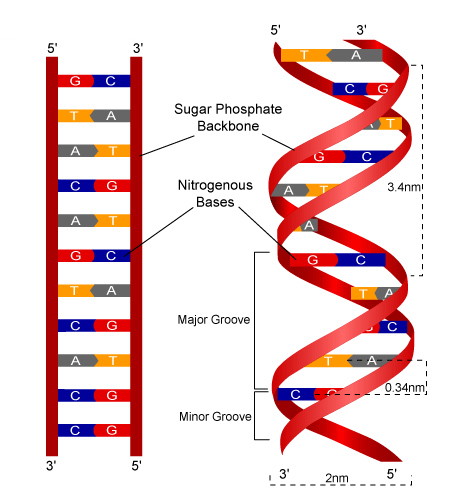
Compare DNA in prokaryotes and eukaryotes
E: combination of DNA and histone proteins found in nucleus (chromatin) - linear and organised
P: DNA found in cytosol as unbound, circular DNA
What is the structure of chloroplast and mitochondrial DNA?
They are small and circular, not wrapped around histones - (like bacterium DNA) - there are usually many copies of DNA in a single mitochondrion/chloroplast
Similarities between DNA in mitochondria and chloroplasts are important in the endosymbiont theory, suggesting that they originated as free-living prokaryotic cells
Function of DNA
To store and contain the genetic information that codes for traits (passed on to future generations) - life needs this to continue
Distinguishing features between prokaryotic and eukaryotic cells

Location and form of DNA in prokaryotes and eukaryotes
E: linear chromosome in membrane bound nucleus with genetic information
P: circular chromosome in nucleoid region with genetic information
What is the process of DNA replication?
The process where DNA undergoes to make a complete and identical copy of itself (preparing for cell division and ready to divide for growth) - an exact copy is needed
Consisting of one parental strand and one new strand
Why is DNA replication semi-conservative?
One of the two strands is conserved or retained from one generation to the next, while the other strand is new
Name enzymes involved in DNA replication:
DNA helicase
DNA polymerase
RNA primase
DNA ligase
What does DNA helicase do?
Unwinds and separates the double strand, breaking the hydrogen bonds
What does DNA polymerase do?
Adds free nucleotides to the template strand in a 5’ to 3’ direction
What does RNA primase do?
Attaches short segments to DNA to show polymerase where to go/start adding nucleotides
What does DNA ligase do?
Removes the primers
Explain the central dogma of protein synthesis
Describes the flow of genetic information from DNA (transcribed) to RNA (translated) to protein - only flows in one direction
What is epigenetics?
Refers to factors that effect the expression of genes that may be inherited
Epigenetic processes are important in the development of cancer and differentiation of embryonic tissues
What does acetylation mean?
It means that the genes are ‘switched on’ by acetyl tags on the histones
Form of histone modification that enhances gene expression. It loosens the interactions between DNA and histones, allowing easier access to DNA
What does methylation mean?
The turning off of genes - silencing
These are added to a cytosine in the DNA that are next to guanine
Methyl tags block transcription factors from binding to DNA
Causes DNA to bind more tightly to histones
Interactions leading to gene expression?
Cell signaling
Paracrines and Autocrines: chemical signals nearby and within a cell
Hormones
Environmental factors
What is RNA?
Ribonucleic acid
A single-stranded molecule with ribose sugar (instead of deoxyribose sugar)
Contains uracil instead of thymine but still contains a nucleotide
Compare DNA with RNA

Function of Antibodies:
Specialised proteins that defend the body from antigens - travel through blood stream to identify/defend bacteria/viruses
E.g. IgG
Function of contractile proteins
Responsible for movement and involved in muscle contraction + movement.
E.g. Actin in the cytoskeleton
Function of enzymes
Facilitate biochemical reactions, speeding up the chemical reactions.
E.g. Lactase - breaks down the sugar lactose in milk
Function of hormonal proteins
Messenger proteins which help coordinate certain bodily activities
E.g. Insulin - regulates metabolism by controlling the blood-sugar concentration
Function of structural proteins
Fibrous, stringy and provide support.
E.g. collagens - support for connective tissues, such as tendons and ligaments
Function of storage proteins
Store amino acids
E.g. Ovalbumin - found in egg whites
Function of transport proteins
Carrier proteins that move molecules from one place to another around the body.
E.g. Hemoglobin transports oxygen through the blood
What are proteins?
large biomacromolecules and macromolecules that contain one or more long chains of amino acid residues
What is protein synthesis
Process where cells produce proteins from instructions encoded in genes found in the coding section of the cell’s DNA (two steps transcription + translation)
Involves transcription of a gene into mRNA in the nucleus
mRNA is translated into amino acids
Steps of transcription
RNA polymerase binds to the promoter site of the DNA
RNA polymerase separates the DNA strands
New nucleotides are inserted to the template strand, thymine is replaced with Uracil
This continues until the terminator is reached
As RNA polymerase moves along the DNA, the hydrogen bonds are reformed
Steps of translation
mRNA attaches to ribosome
As mRNA moves along ribosome, tRNA brings in an amino acid
The ribosome hitches together the amino acids to form polypeptide chains
When the end is reached, the polypeptide is sent to ER to be modified into functioning protein
How to read an amino acid table?
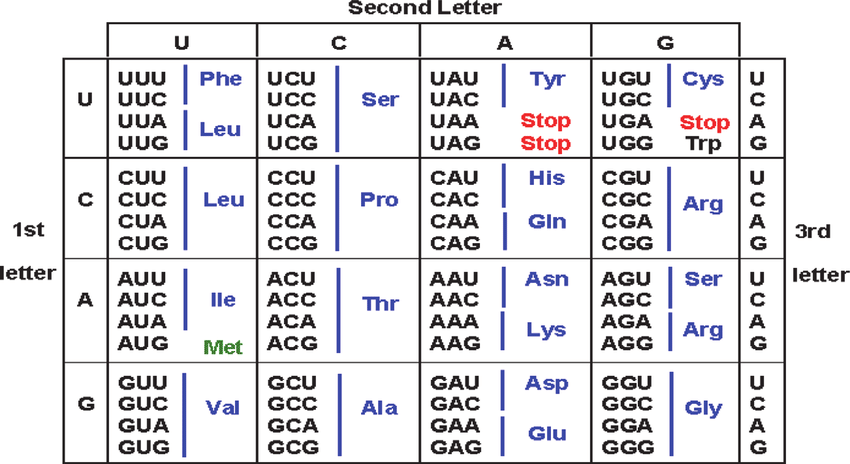
What does the redundancy/degeneracy of the genetic code mean?
It means that multiple codons can specify the same amino acid
This is because there are 64 possible codons but only 20 amino acids
What is the end product of mRNA?
A polypeptide - synthesised through process of translation
What is an exon?
The coding region of RNA/DNA
What is an intron?
Non-coding region of RNA/DNA
Role of mRNA
Messenger RNA: transports the code from the nucleus into the cytoplasm and the ribosome
*carries information
Role of tRNA
Transfer RNA: found in the cytoplasm, a tRNA carries a specific amino acid to the ribosome for incorporation into the growing peptide.
tRNA anticodon matches opposite codon in the mRNA
Role of the ribosome
Acts as the site where mRNA is (read) translated into a specific sequence for amino acids, forming a polypeptide chain of protein
What are anticodons?
A set of three consecutive nucleotides (part of tRNA molecule) and is complementary to a codon
Sequence is read three bases at a time
Difference between triplet code, anti-codons, and codons
Triplet code: sequence of three nucleotides in mRNA/DNA that determines a specific amino acid or stop signal
Anti-codon: sequences of three nucleotides on tRNA that is complementary to a codon on mRNA
Codon: a specific sequence of three nucleotides that codes for a particular amino acid or stop signal (during protein synthesis)
mRNA codon table
just know that it lists the codons for each of the 20 amino acids
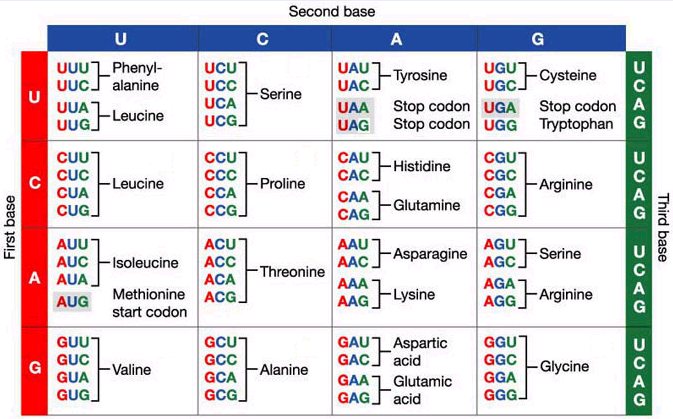
What is gene expression
The gene being transcribed into mRNA and translated into a protein
Regulated by proteins that bind to a specific base sequence in DNA
Impacts on gene expression:
Environment of a cell and organism: can influence the way genes are expressed (affects chromatin structure and gene expression)
E.g. diet, stress, toxins, hormones, temperature
What helps regulate transcription - eukaryotes
Nucleosomes: act as physical barriers and a substrate for epigenetic modifications that can affect the transcription process of DNA
Provide the “architectural framework” for transcription
What is binary fission ? (process)
Asexual reproduction where a prokaryotic cell divides into two identical daughter cells
DNA SEGREGATES AND CELL DIVIDES ALL IN ONE STEP
single chromosome is tightly coiled (prior)
Genetic material in chromosome uncoils and replicates
Original and replicate chromosomes attach to cell membrane and are pulled to separate poles as cell elongates
New cell wall starts to grow cleavage furrow develops in cell membrane
New cell wall fully develops
2 cells separate (cytokinesis), forming two identical daughter cells
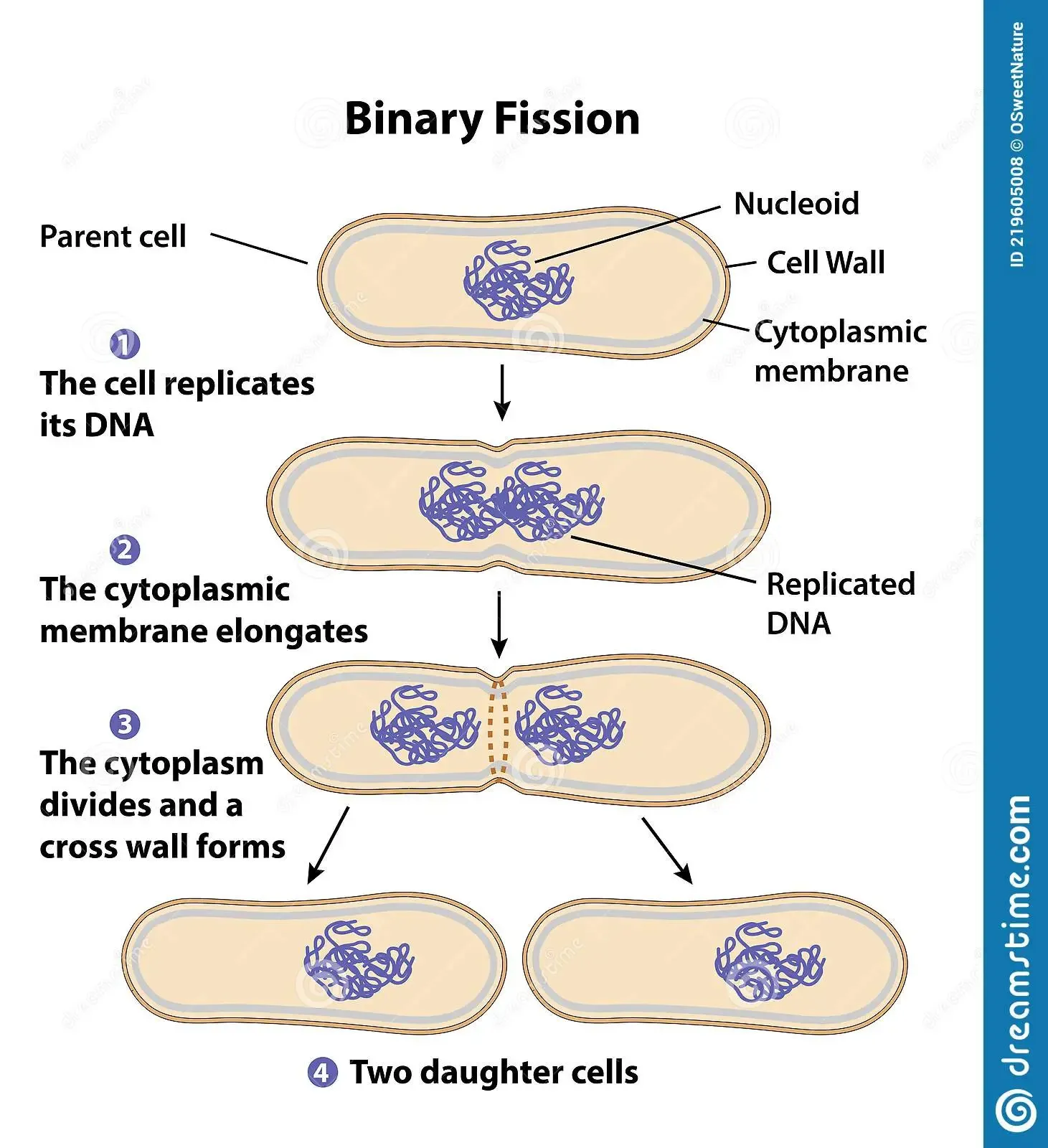
The steps of mitosis:
Type of nuclear division in somatic cells that maintains the parental diploid number of chromosomes in the daughter cells
Prophase:
Chromatin threads condense to form chromosomes (two sister chromatids held together by centromere)
Nuclear membrane disintegrates and nucleolus disappears
Spindle begins to form, fibres attach to each chromsome at its centromere
Metaphase:
The chromosomes move to the centre of the cell and line up along the equator
Centromeres of chromosomes are aligned on the equator
Spindle fibres attach to the centromere
Anaphase:
Sister chromatids separate and are pulled to opposite part of the cell
Each pole has complete identical set of maternal and paternal chromosomes
Sister chromatids are now chromosomes
Telophase
Chromosomes decondense (forms chromatin)
Two new nuclear envelopes form (one for each new daughter cell)
Spindle disappears
Cell elongates and is ready for cytokinesis to separate.
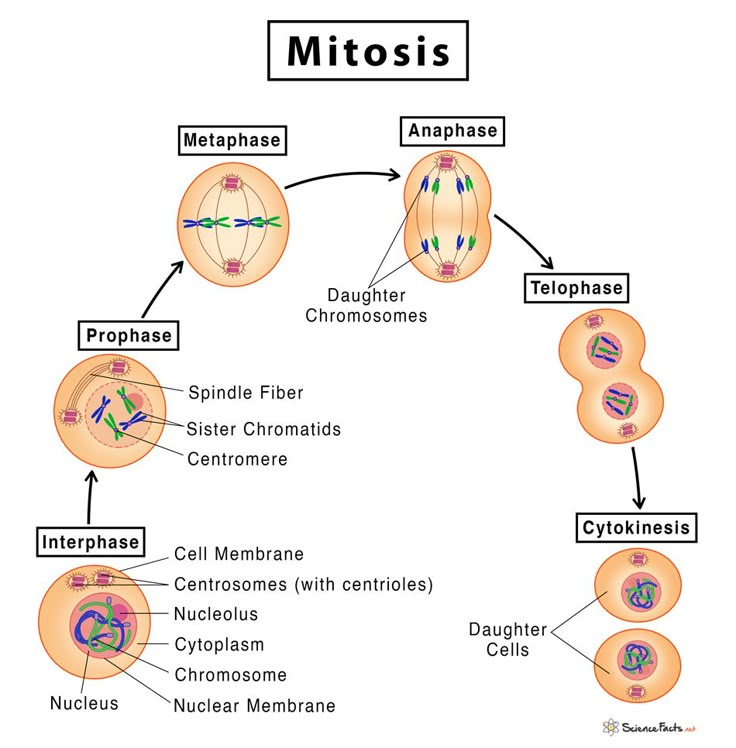
Compare mitosis and meiosis (with drawings)
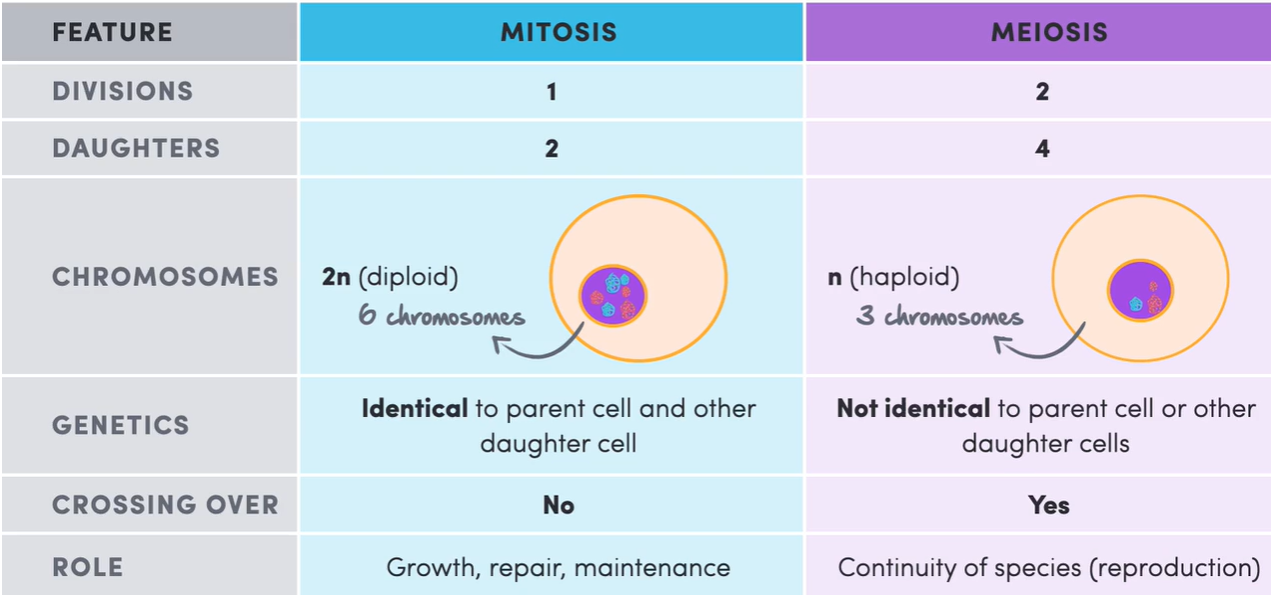
Process of meiosis
Type of cell division that produces gametes with half the number of chromosomes as the original cell
Prophase I:
Chromosomes condense + become visible
Homologous chromosomes (matching pairs) pair up
Crossing over: sections of DNA are exchanged between homologous chromosomes (increasing genetic diversity)
Metaphase I:
Homologous chromosome pairs line up in middle of cell
Independent assortment: chromosomes are randomly arranged (variation)
Anaphase I:
Homologous chromosomes are pulled apart to opposite ends of cells
Telophase I & Cytokinesis:
2 new cells form, each with half the original chromosome number (haploid)
Nuclear membranes may form temporarily
MEIOSIS II (similar to mitosis)
Prophase II:
Chromosomes condense again in born cells
Spindle fibres form
Metaphase II:
Chromosomes line up at the centre of the cell
Anaphase II:
Sister chromatids are pulled apart to opposite sides
Telophase II & Cytokinesis:
4 haploid cells form, each genetically unique
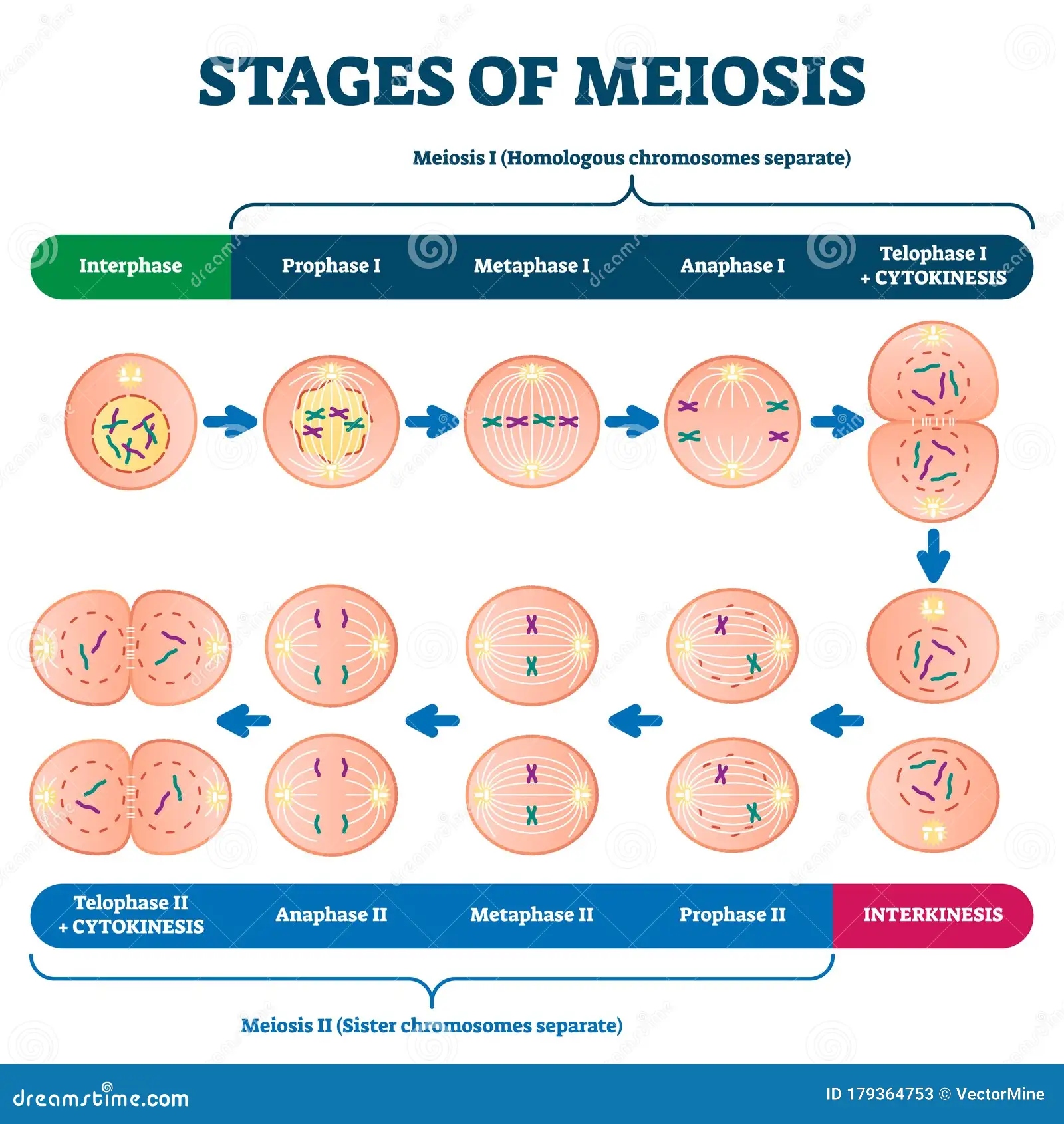
Where does meiosis occur?
Males: testes (sperm cell)
Females: ovaries (egg cell)
Process of fertilisation
(leads to variation)
Any sperm can fertilise any egg, leading to even more variation
Creates a new organism allowing life to continue
Is the DNA sequence unchangeable?
No
May arise spontaneously during DNA replication, or cell division, or may be induced by physical or environmental factors (mutagens), or through biological agents.
What is a mutagen?
An agent capable of inducing mutations
What is a mutation?
A source of new alleles - a permanent change in the DNA sequence of an individual
What are the types of physical mutagens?
UV LIGHT: structural distortion by cross-linking neighboring nucleotides
X-RAYS: gene and chromosome aberrations
NUCLEAR RADIATION: breaks in DNA strands
High energy radiation causes damage to DNA
What are the types of chemical mutagens?
MUSTARD GAS: affects guanine, causing substitution mutation
2-AMINOPURINE, 5-BROMURACIL: nucleotide substitution
COLCHICINE: prevents spindle formation in mitosis; doubles chromosome number
NITRIC ACID: adenine in DNA is deaminated (behaves like guanine)
Difference between somatic and gametic mutations (and their effects)
Somatic - MITOSIS: occurs in body cells and are not inherited
E.g. mutations that lead to cancer (in a tissue)
Gametic - MEIOSIS: occur in reproductive cells (gametes) and can be passed on to offspring
E.g. Embryo becomes diploid (2 haploid gametes fusing)
What are cell division errors?
Occurs during mitosis or meiosis and is when the chromosomes aren’t sorted properly and end up with less or more chromosomes
Can result in unequal crossing over when chromosomes are misaligned
What are DNA replication errors
Base-pair substitution results in either a mistake being fixed or a mutation
But this is rare as DNA mechanisms are very effective
What are point mutations (and examples)
A genetic alteration where a single nucleotide base in RNA or DNA is changed, can be neutral, harmful or beneficial to the organism
Includes substitution, insertion and deletion
What is insertion/deletion?
Mutation where one or more nucleotide pairs have been added/deleted to a segment of DNA
FRAMESHIFT MUTATION - READING FRAME CHANGES
Codons are read wrong and the wrong amino acid is added to a protein
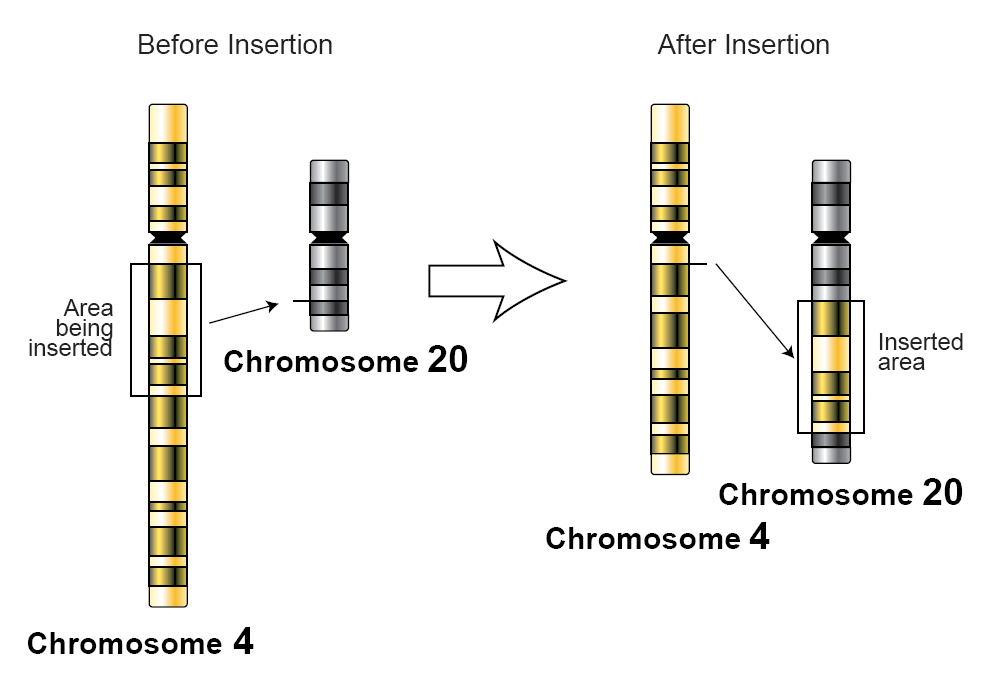
What is substitution?
A mutation where a single nucleotide is swapped for another in the original gene sequence
Missense: base substituted codes for a different amino acid, a different amino acid is made
Silent: base substituted still codes for the same amino acid, no effect
Nonsense: base substituted produces a stop codon, protein can no longer be made
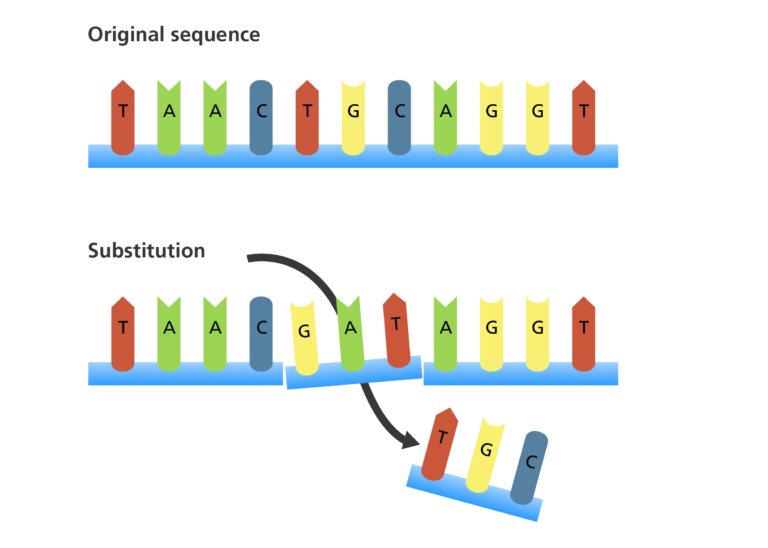
What are chromosomal mutations?
Changes in the number or structure of chromosomes (may alter gene locations or copy numbers leading to genetic disorder)
What is monoploidy and one effect
Number change:
An individual that contains one half the normal number of chromosomes
Effect: unmasks harmful alleles
*very rare
What is polyploidy and one effect?
Number change
When an organism gains a full set of extra chromosomes
Lethal in humans, but common in plants
Chromosomal mutation during meiosis where cells contain more than 2 haploid (n sets) of chromosomes
What is aneuploidy and one effect?
Number change:
NON-DISJUNCTION:
When an organism gains or loses an extra chromosome
E.g. trisomy: down syndrome (extra chromosome 21)
Results in the formation of two types of gametes in equal proportions (one type has two copies of a particular chromosome and the other has none).
What is deletion and its effect?
Structure change:
The loss of nucleotides from a site within the original gene
Effect: frame shift mutation - reading frame for the corresponding amino acids has been nudged away from the original (all codons downstream of mutation are affected)
Non-coding section: no effect
Coding section: lost, proteins not made

What is inversion and its effect?
Structure change:
Chromosome segment breaks off, flips around backwards, and reattaches.
Effect: less dramatic, may disrupt a gene where it causes two different genes to fuse together. If chromosomes do not align properly affected individual may have reduced fertility
What are translocations and its effect?
Structure change:
When a section of one chromosome breaks off and reattaches to another
Effect: several negative impacts but commonly links to cancer and infertility
What are duplications and its effects?
Structure change:
When an extra copy is made of a section of a chromosome and inserted either into the same chromosome or another.
Effect: harmful and advantageous:
gain of new function of organism or commonly results in protein function loss
Why is Mendel’s work important?
He was the founder of genetics and through his work with pea plants he discovered the basics from which all genetics stems
Mendelian inheritance refers to how certain traits are inherited in a predictable way, for a monohybrid cross, and that dominant alleles will mask recessive alleles
What are Mendel’s three laws?
Law of dominance
Hybrid offspring’s will only inherit the dominant trait in the phenotype, alleles suppressed are the recessive traits (masked)
Law of independent assortment:
States that a pair of trait segregates independently of another pair during gamete formation. As the individual heredity factors assort independently, different traits get equal opportunities to occur together.
Law of segregation
States that during production of gametes, two copies of each hereditary factor segregate so offspring get one factor from each parent
State Mendel's laws to predict inheritance when there are 2 different genes
Law of Segregation and law of independent assortment:
Segregation states that alleles for a trait separate during gamete formation, while independent assortment states that alleles for different traits assort independently during gamete formation
What is incomplete dominance?
When neither allele ‘dominates’ the other. Both alleles are present in the heterozygous genotype and both contribute to a phenotype (3 phenotypes may occur)
E.g. Snapdragon with RR (Red) WW (white) RW( (pink)
What is codominance?
When both alleles are equally dominant. Both present in the heterozygous genotype and combine.
E.g. Speckled chicken, BB (black), WW (white), BW (white and black spots)
How are genes with multiple alleles inherited?
Occurs with genes that have more than 2 different alleles, though an individual will only have two of the alleles in its genotype
E.g. Inheritance of human blood groups show multiple alleles, complete dominance, and co-dominance.
What is polygenetic inheritance and why do some genes show in continuous variation?
Polygenetic inheritance: Transmission between generations of characteristics that are controlled by polygenes
Some genes show continuous variation because traits such as height and eye colour fall among a range of values rather than being categorised into a group
How are genes on the sex chromosome inherited?
Genes on the sex chromosomes are sex-linked.
The X comes from the mother, and the Y comes from the father
Females: receive one X from the mother and one X from the father
Males: receive one X from the mother and one Y from the father
Identify the symbols on a pedigree chart:
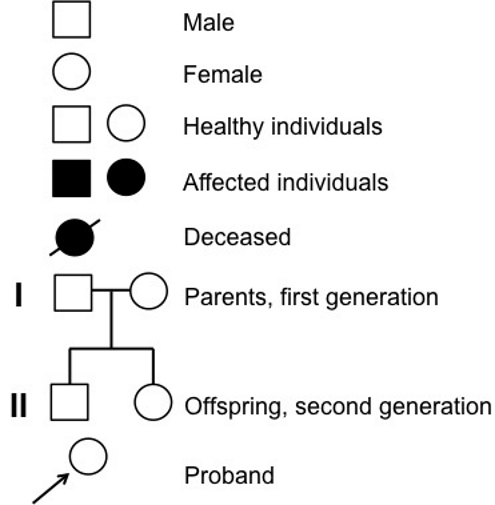
How are genes with multiple alleles inherited?
Each gene can have several different versions (alleles) but an individual can only carry two - one from each parent
Rules for a sex-linked inheritance pattern?
Affected female has to have an affected father
Affected males cannot have affected sons
Therefore would be autosomal
Rules for autosomal inheritance pattern? (Dominant vs Recessive)
If it is recessive, affected offspring can’t have affected parents
If two affected parents have an affected child, it must be dominant
Life cycle of a cell?
The sequence of events from one cell division to another
Begins when the cell is formed from its parent cell and completed with its own division.
Stage between cell divisions is called interphase, incorporates a period of metabolic activity and growth (G1), duplication of chromosomes and centrosomes (Synthesis phase), and further growth and reproduction of organelles as the cell prepares to divide (G2)
Cells in G0 have withdrawn from the active cell cycle and can only re-enter the cell under certain circumstances
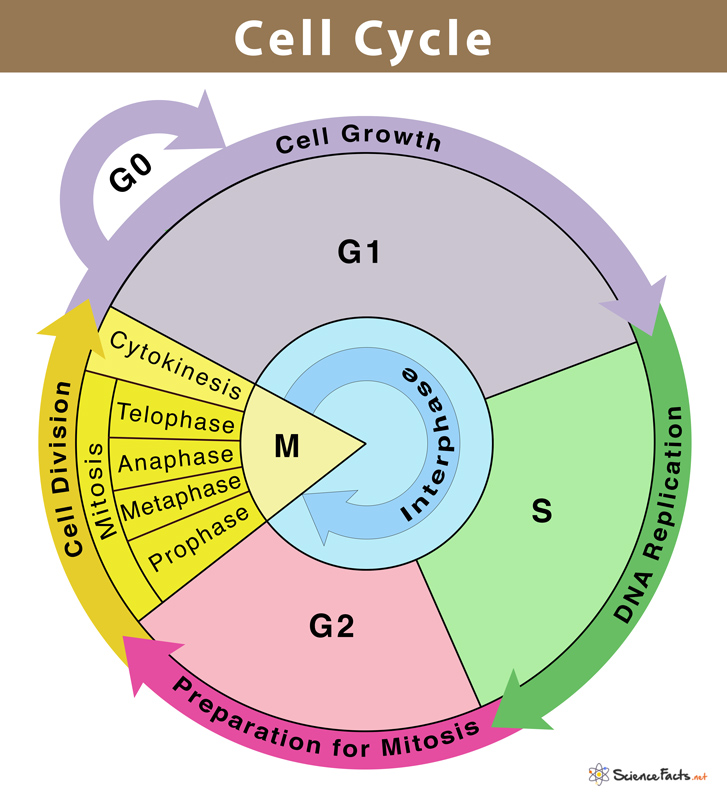
What does a genome consist of?
All the nucleotides, the complete set, in the DNA of the cell
Contains all the information needed for a cell's growth, survival and replication
Describe the movement of the genetic material in a cell during the cell cycle
During interphase, cells that undergo division go through phases where genetic material replicates within the nucleus.
In mitosis, chromatin threads condense to form chromosomes. As the nuclear membrane disintegrates, the chromosomes move to the center of the cell. Chromatids are separated by shortening of spindles, pulling each chromatid towards the opposite pole of the cell. Newly formed nuclear membranes form around decondensed chromatin.
The cell undergoes cytokinesis, forming two identical daughter cells and marking one full cycle